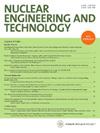与花岗岩地区有关的放射性矿物的地球化学评价和危害指数
IF 2.6
3区 工程技术
Q1 NUCLEAR SCIENCE & TECHNOLOGY
引用次数: 0
摘要
本研究采用统计方法来评估埃及 ELgarra 地区花岗岩含矿可能造成的放射性危害。地质结构影响了该地区铀矿化的发生,主要与蚀变花岗岩有关。利用伽马射线光谱法检测了花岗岩样本中 238U、232Th 和 40K 的数量。在分析区域记录到的 238U 放射性同位素活度浓度范围为 374 至 1740 Bq.kg-1,平均为 1018 Bq.kg-1。就 232Th 而言,范围在 71 至 163 Bq.kg-1 之间,平均为 119 Bq.kg-1。最后,40K 的范围为 756-1789 Bq.kg-1,平均为 1212 Bq.kg-1。在所检测的岩石样本中,238U、232Th 和 40K 的检测水平分别超过了 35、45 和 412 Bq.kg-1 的允许限值。与这些花岗岩有关的主要放射性风险归因于放射性元素释放的伽马射线。对花岗岩中的放射性危害进行了估算,并利用统计方法证明了放射性核素和放射性因素之间的关联。评估结果证实,花岗岩中的铀、钾及其各自的矿物是造成放射性风险的关键因素。因此,研究确定,在研究区域发现的花岗岩石由于放射性水平较高,需要采取预防措施。本文章由计算机程序翻译,如有差异,请以英文原文为准。
Geochemical evaluation and hazard indices due to radioactive minerals associated with granitic areas
The present study employed statistical methods to evaluate the possible radiological hazards linked to granitic rocks-bearing mineralization in the ELgarra region of Egypt. The geological structures influence the occurrence of uranium mineralization in this area and are primarily associated with altered granites. Gamma-ray spectrometry was utilized to examine the quantities of 238U, 232Th, and 40K in granitic rock samples. The recorded levels of radioisotope activity concentrations in the analyzed regions ranged from 374 to 1740 Bq.kg−1 238U, with an average of 1018 Bq.kg−1. For 232Th, the range was between 71 and 163 Bq.kg−1, with an average of 119 Bq.kg−1. Lastly, for 40K, the range was 756–1789 Bq.kg−1, with an average of 1212 Bq.kg−1. The detected levels of 238U, 232Th, and 40K in the examined rock samples were observed to exceed the permissible limits of 35, 45, and 412 Bq.kg−1, respectively. The primary radiological risks linked to these granitic rocks were attributed to the gamma rays released by the radioactive elements. Estimations of the radiological hazards in the granitic rocks were made, and statistical approaches were utilized to demonstrate the associations among radionuclides and radiological factors. The assessment confirmed that uranium, potassium, and their respective minerals in the granitic rocks were the key factors contributing to the radiological risks. As a result, the study determined that the granite rocks found in the study area needed precautions to be taken due to their high levels of radioactivity.
求助全文
通过发布文献求助,成功后即可免费获取论文全文。
去求助
来源期刊

Nuclear Engineering and Technology
工程技术-核科学技术
CiteScore
4.80
自引率
7.40%
发文量
431
审稿时长
3.5 months
期刊介绍:
Nuclear Engineering and Technology (NET), an international journal of the Korean Nuclear Society (KNS), publishes peer-reviewed papers on original research, ideas and developments in all areas of the field of nuclear science and technology. NET bimonthly publishes original articles, reviews, and technical notes. The journal is listed in the Science Citation Index Expanded (SCIE) of Thomson Reuters.
NET covers all fields for peaceful utilization of nuclear energy and radiation as follows:
1) Reactor Physics
2) Thermal Hydraulics
3) Nuclear Safety
4) Nuclear I&C
5) Nuclear Physics, Fusion, and Laser Technology
6) Nuclear Fuel Cycle and Radioactive Waste Management
7) Nuclear Fuel and Reactor Materials
8) Radiation Application
9) Radiation Protection
10) Nuclear Structural Analysis and Plant Management & Maintenance
11) Nuclear Policy, Economics, and Human Resource Development
 求助内容:
求助内容: 应助结果提醒方式:
应助结果提醒方式:


